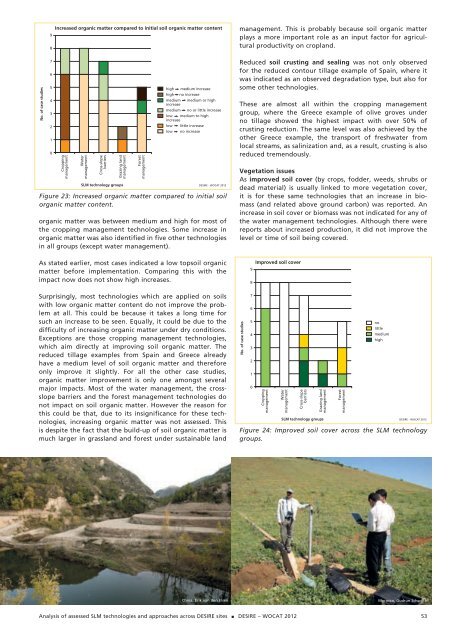Desire for Greener Land
Desire for Greener Land
Desire for Greener Land
You also want an ePaper? Increase the reach of your titles
YUMPU automatically turns print PDFs into web optimized ePapers that Google loves.
No. of case studies<br />
Increased organic matter compared to initial soil organic matter content<br />
9<br />
8<br />
7<br />
6<br />
5<br />
4<br />
3<br />
2<br />
1<br />
0<br />
Cropping<br />
management<br />
Water<br />
management<br />
Cross-slope<br />
barriers<br />
Grazing land<br />
management<br />
SLM technology groups<br />
high medium increase<br />
high no increase<br />
medium medium or high<br />
increase<br />
medium no or little increase<br />
low medium to high<br />
increase<br />
low little increase<br />
low no increase<br />
organic matter was between medium and high <strong>for</strong> most of<br />
the cropping management technologies. Some increase in<br />
organic matter was also identified in five other technologies<br />
in all groups (except water management).<br />
As stated earlier, most cases indicated a low topsoil organic<br />
matter be<strong>for</strong>e implementation. Comparing this with the<br />
impact now does not show high increases.<br />
Surprisingly, most technologies which are applied on soils<br />
with low organic matter content do not improve the problem<br />
at all. This could be because it takes a long time <strong>for</strong><br />
such an increase to be seen. Equally, it could be due to the<br />
difficulty of increasing organic matter under dry conditions.<br />
Exceptions are those cropping management technologies,<br />
which aim directly at improving soil organic matter. The<br />
reduced tillage examples from Spain and Greece already<br />
have a medium level of soil organic matter and there<strong>for</strong>e<br />
only improve it slightly. For all the other case studies,<br />
organic matter improvement is only one amongst several<br />
major impacts. Most of the water management, the crossslope<br />
barriers and the <strong>for</strong>est management technologies do<br />
not impact on soil organic matter. However the reason <strong>for</strong><br />
this could be that, due to its insignificance <strong>for</strong> these technologies,<br />
increasing organic matter was not assessed. This<br />
is despite the fact that the build-up of soil organic matter is<br />
much larger in grassland and <strong>for</strong>est under sustainable land<br />
Forest<br />
management<br />
DESIRE - WOCAT 2012<br />
Figure 23: Increased organic matter compared to initial soil<br />
organic matter content.<br />
management. This is probably because soil organic matter<br />
plays a more important role as an input factor <strong>for</strong> agricultural<br />
productivity on cropland.<br />
Reduced soil crusting and sealing was not only observed<br />
<strong>for</strong> the reduced contour tillage example of Spain, where it<br />
was indicated as an observed degradation type, but also <strong>for</strong><br />
some other technologies.<br />
These are almost all within the cropping management<br />
group, where the Greece example of olive groves under<br />
no tillage showed the highest impact with over 50% of<br />
crusting reduction. The same level was also achieved by the<br />
other Greece example, the transport of freshwater from<br />
local streams, as salinization and, as a result, crusting is also<br />
reduced tremendously.<br />
Vegetation issues<br />
As improved soil cover (by crops, fodder, weeds, shrubs or<br />
dead material) is usually linked to more vegetation cover,<br />
it is <strong>for</strong> these same technologies that an increase in biomass<br />
(and related above ground carbon) was reported. An<br />
increase in soil cover or biomass was not indicated <strong>for</strong> any of<br />
the water management technologies. Although there were<br />
reports about increased production, it did not improve the<br />
level or time of soil being covered.<br />
Improved soil cover<br />
9<br />
Analysis of assessed SLM technologies and approaches across DESIRE sites DESIRE – WOCAT 2012<br />
No. of case studies<br />
8<br />
7<br />
6<br />
5<br />
4<br />
3<br />
2<br />
1<br />
0<br />
Cropping<br />
management<br />
Water<br />
management<br />
Cross-slope<br />
barriers<br />
Grazing land<br />
management<br />
SLM technology groups<br />
Forest<br />
management<br />
no<br />
little<br />
medium<br />
high<br />
DESIRE - WOCAT 2012<br />
Figure 24: Improved soil cover across the SLM technology<br />
groups.<br />
China, Erik van den Elsen Morocco, Gudrun Schwilch<br />
53









